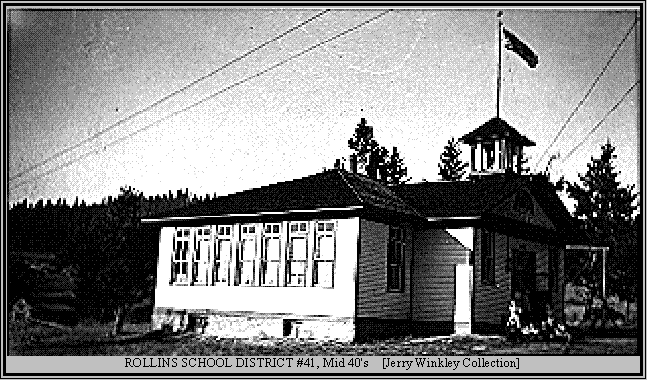Rollins - Graphics
BAY VIEW/TATE/ROLLINS SCHOOL DISTRICT #41J
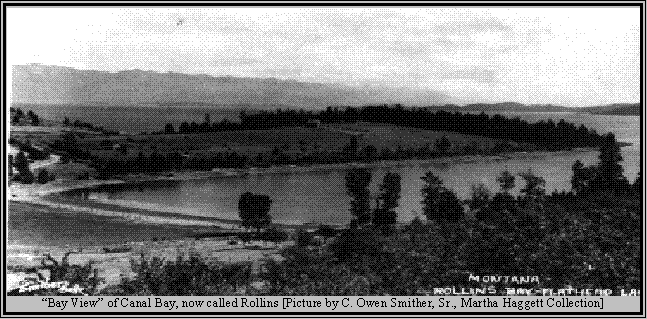
|
Table of Contents |
||
|---|---|---|
Rollins is one of the older non-Indian settlements along the shores of Flathead Lake bounded on the east by Flathead Lake, on the north by Flathead County, on the west by the Proctor school district, and the south by the Flathead Indian Reservation. White settlement began in the 1880s but did not reach its peak until the start of the 20th century. Early settlers included Civil War veterans O. T. Baker and R. A. Rollins; Bud and George Parsons, who together raised horses; the half-brothers Joseph Zelezny and Henry Fingado; and the Baldwins.
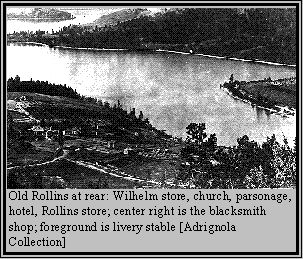 The Joseph Zelezny family story tells much of the settlement history. Before 1891 Joseph Zelezny made two trips to Montana to the Flathead Valley to help his cousin with harvest before Kalispell was founded.
The Joseph Zelezny family story tells much of the settlement history. Before 1891 Joseph Zelezny made two trips to Montana to the Flathead Valley to help his cousin with harvest before Kalispell was founded.
He tells about the train trip to Ravalli, the stage to Polson, a horseback ride on the east side of Flathead Lake to the Bigfork area, and a ferry trip to Demersville. In 1899 he returned to the Flathead Valley to meet his half-brother, Henry Fingado just back from the Spanish American War, to homestead adjoining tracts by the Painted Rocks near Rollins. They spent the first winter in a dugout. They planted a large apple orchard and they built a three-room log cabin which still stands with much of the original furniture and equipment. In 1906 Joseph Zelezny married Bertha "Birdie" E. Loder who had moved to the Kalispell (LaSalle) area soon after 1900.
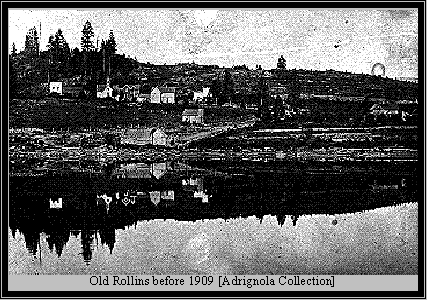
For two years, about 1901 and 1902, long before the Flathead Reservation was opened, Bertha Loder worked as a teacher for the four children of Mr. and Mrs. Andrew Stinger who lived on the old Allard ranch on Mud Creek, about three miles west of Ronan. [Mrs. Stinger was the widow of C.A. Allard, who had been part owner of the famous Pablo-Allard buffalo herd]. When the Flathead Reservation was opened for homesteading in 1910, Joe established a second homestead near Lonepine. While raising apples and cattle, Joe was also a skilled carpenter and worked into the early 1930s building or helping build a number of houses in the Rollins and Creston areas, including the Echo Lake ranger station. The children born to Joseph and Birdie were Eugene, born in 1908, Anna born in 1910, Bill born in 1918, and Betty Mae born in 1920. Mrs. J. Zelezny served as Rollins School trustee in the 1924-25 school year. Then Joseph Zelezny served as trustee from 1927 to 1930. Other early settlers have similar stories.
Early Flathead County records indicate Bay View/Tate District #41 was cut from Proctor/Dayton District #24 on October 14, 1900 and a trustee elected April, 1900 for the new Bay View/Tate District. Classes were held in the Tate house overlooking Canal Bay in the little community
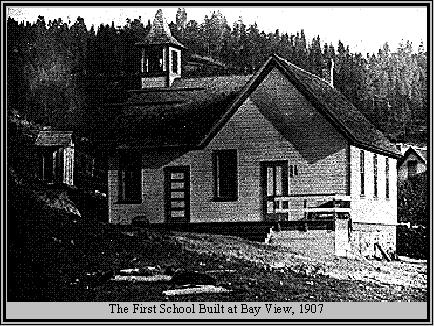
of Bay View until a schoolhouse was built in 1907. The first teachers were Mary Welch and Henry Fingado. According to locals, nearly all the school and library books were labeled "Bay View."
The first schoolhouse was built in 1907 on the west side of Canal Bay. Bill Zelezny states, "This building was a log house built by my father, Joseph Zelezny, who was a carpenter. Ever since I can remember the building has been covered with board siding and has the appearance of a frame house. When I attended the Rollins school (in the present school building) the former school building was occupied by the Tiffany family. Eugene Tiffany was in school at the same time I was. Gene's brother Ed still lives in Polson. That former school building in 1998 is occupied by the G.T. Dedman family."
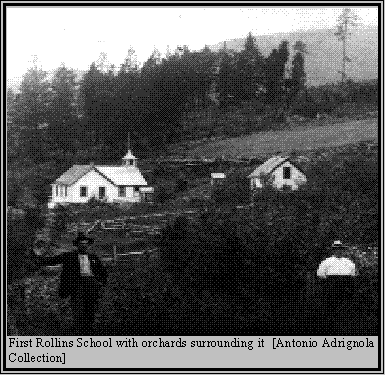
Mrs. Dean King of Kalispell also taught. The Edward Ekman children, Lynn and his sisters, attended this first school as they came to the area in 1906. Harold Hyer, son of Jim and Anna Hyer from New York state, walked or rode a bicycle from his home near Table Bay Resort to school at Rollins. A fellow student was Ritchie Wymore who later married Lynn Ekman. When winter closed in, Anna Hyer taught her son at home by the huge fireplace. In those early days (1909-1911) they were supplied with mail and groceries when Cap Palmer would stop by on his regular run from Somers to Big Arm. They would hear the welcome "toot, toot" from the "Montana", "Eva Bee", "Klondike" and "City of Polson" as these big stern wheelers plied the waters of Flathead Lake.
When the reservation was opened for homesteading in 1910, they bought a lakeshore lot on Finley Point fronting Skidoo Bay and built
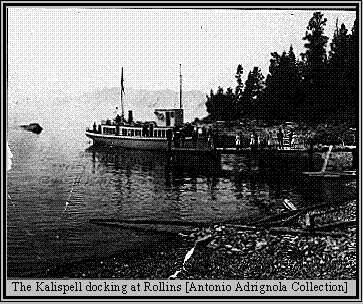
a hunting and fishing cabin that they later remodeled into a year-round home. Later, when Harold was a young man, he did part of the hand digging for the water line for the City of Polson from Hell-Roaring. In 1910 about 70 students were enrolled with two teachers employed at this first school building of Bay View. Elgie Sager (1897 to 1993) went to school for several years in the first school house of Rollins located in Canal Bay until they moved into the new school up the hill.
Construction of the Rollins School House
The area was not called Rollins until 1910. It was renamed for Renault Rollins, who with his family was amongst the first settlers in the area.
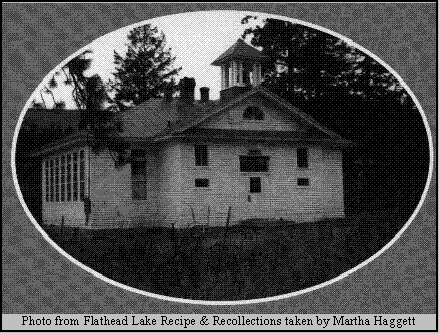
The new two-room schoolhouse was constructed on the east side of Canal Bay in 1911-1912 on land donated by Ed Ekman. Ed Ekman was a stone mason who had come from Kalispell in 1906. He built the foundation. Ramona Ekman Warren says her grandfather Ed also laid the beautiful hardwood floors that were so much fun to dance on. First the floors were three inch tongue and groove softwood floors with the hardwood floors laid sometime in the thirties. The school was constructed by Richard Louis Uhde, uncle of Fred Uhde who with his brother and sisters would attend the Rollins grade school. (Richard Uhde left the community and returned as an elderly man to work in Fred's store where he was known as "Uncle Dick" to the whole community.)
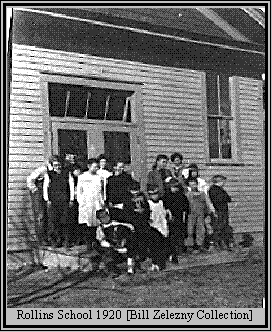
Tony Adrignola wrote, "Nearly all the material for the new schoolhouse was furnished by Will Dewey of Polson, who with a partner, a Mr. Cox, operated a sawmill and planer in Lone Cabin Bay, called Dewey's Bay by some . . ." In the early thirties the WPA came in and dug out the cellar adding a basement with cement walls inside the original foundation. A kitchen has since been added in that basement.
William F. Zelezny remembers his grade school years at Rollins from 1926 to 1932 [Bill Zelezny and wife Virginia now live in retirement on the homesteaded property ofhis parents at Rollins]:
I did not start at six because we lived through the deep, dark woods two miles from the school. My older sister, Anna, was terribly frightened from seeing a wolf on the edge of the clearing . This scared the family and Mother held me back until I was eight teaching me to read herself so my younger sister Betty Mae and I could walk together. Betty Mae and I walked through the forest by ourselves, fall, winter and spring, to attend school from 1926 to 1932. We estimated the distance each way as about two miles, and it took us almost an hour each way. On rare occasions when our parents had a reason to go to the Rollins store or post office they would take us by row boat.
As a younger classmate of Bill Zelezny, Ramona Ekman Warren, still of Rollins, also remembers those years at Rollins in the mid-twenties and early thirties. Moroea (later Mrs. Harris Weaver) and Ramona Ekman went through all eight grades at the Rollins grade school. The memories of Bill and Ramona give us this picture of the Rollins School:
The Rollins school house is a two-room building, but during our first four years only one room was occupied and there was only one teacher. There was a second room. It was used for programs of every kind. With all eight grades for many years in one room, there was a class of some
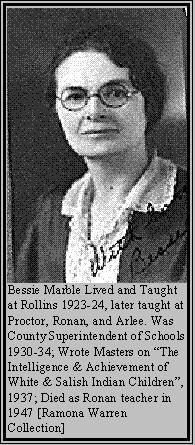
sort being taught all through the day. We all learned to get our work done even though there was some sort of recitations going on. During the latter years both rooms were open as there were enough students and there were two teachers.
Heat was provided by a wood stove in each room. The stoves were surrounded by high, round enclosures, a protective guard, so there was no chance of students running into the stoves and burning themselves. Ramona adds, "We had cloak rooms where we hung our coats, and other necessary items. Our lunches froze, so after morning recess, they were brought in to thaw out by the stove." Bill tells, "One year my father was awarded the contract for providing the firewood for the school. It was sawed by hand with a cross-cut saw and loaded by hand into the wagon. It seems to me that the price was either $4.00 or $8.00 a cord."The teacher was almost always the janitor. She came early to start the fire, she also played games with us.Bill wrote:
At one time it was decided that each family would take turns in providing a hot dish to supplement the lunches that each student carried to school. I remember that my mother sent a stewed chicken. This program lasted about a week and then withered away. The students depended on the lunches they brought from home. The most common lunch box was the container in which 4 pound batches of lard were purchased. It was a small bucket with a tightly fitting cover and a bail which was convenient for carrying. I still have the buckets and cups that Betty Mae and I carried. We used those cups for drinking from the stone crock with a spigot. But some children made their own drinking cups by rolling and folding their pencil tablet paper.
Ramona said, "We had our drinking water in a big bucket, and all used the same drinking dipper. She goes on tofill out more site specifics: "There was an outside toilet, one for
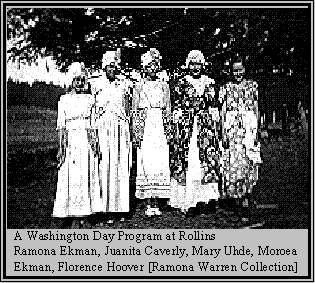
the boys and one for the girls. We all learned to either be pelted with snowballs or apples. The apple tree still bears fruit, after these many years." Bill tells:
Occasionally over our years in school there was a visit from the county superintendent of schools. Remember Mrs. Marble and Mrs. Ethel Terry who would be there for a couple of hours and listen in. Also, possibly two or three times during our entire years in school, there was a call from a visiting nurse. She would do things such as weigh the students and measure their height, have them say "Ahh!" while looking down their throats and have them read eye charts. She would record findings and comments on cards for the students to take home to their parents. There was no mention of vaccinations at that time. Possibly a few of the more affluent and enlightened parents had obtained the few kinds of vaccinations that were available at that time for their children, but most of us did not receive any vaccinations. I had my first vaccination when I was in college. The Indians must have been more advanced as during my high school years in Lone Pine I remember a blond-blue-eyed girl bravely baring her upper arm for a vaccination given only to Indian students. During our time in school there was a measles epidemic, but we were spared encounters with other dangerous diseases such as polio, diphtheria and whooping cough.
Several annual events involved the school and the entire community. The first of these was the Halloween party. It was held in the evening and I remember in particular the apple cider and the pumpkin decorations. At that time there were no electric lights anywhere in Rollins or any other small community along the lake shore and no running water. The only illumination available was daylight from the windows and that seemed to be adequate. For lighting at evening events at the school house somebody brought two gasoline lamps or lanterns and suspended them from hooks in the ceiling at each end of the room.
The Christmas party was the highlight of the year and was held in the evening.
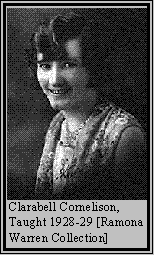
The students presented several Christmas plays, and, in retrospect, their preparation and rehearsals took considerable time away from the usual academic duties. The stage, at one end of the room, consisted of planks supported by low saw horses. The curtains were bed sheets suspended from a wire stretched across the room. Bill had a brief acting career as Scrooge in Dickens Christmas Carol which the sixth grade class dramatized for the others, " I was voted by my classmates as best at saying, "Bah humbug!" Decorations included a Christmas tree, on or under which were placed presents which students exchanged by drawing names. In addition, Santa Claus brought each student "an orange, perhaps an apple, popcorn balls and some candy. We received one present as we had a gift exchange with our classmates. The teacher always received a gift from each of us and she gave us a gift too," said Ramona.
The annual school picnic at the end of each school year was a pot-luck affair attended by all of the families and usually was held on the free camping ground on Dewey Bay. That area is now covered with houses.
Events which involved only the school and not the outside community were Valentine's Day and school yard cleanup day. On Valentine's the students exchanged valentines, many of them homemade. On clean up day the school yard was raked and enough branches were gathered in the process to make a fire on which weiners and marshmallows were roasted.
Ramona wrote about the teachers:
We were taught to respect the teacher and my fondest memories are of them. I remember Clarabell
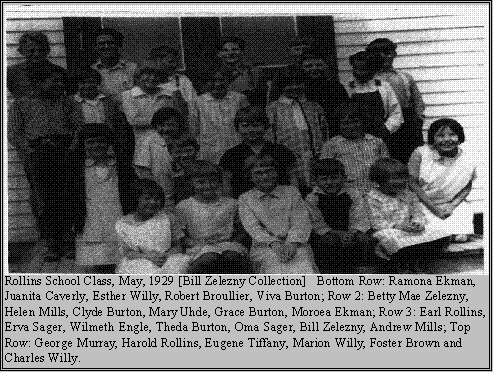
Cornelison, Ruth McAlear (who married Slim Coppedge), Helen Benz, Laura Novack, George Siderius (my only man teacher) his sister Jenny Siderius, Mrs. Merritt (1928-29), Phyllis Smith (1931-35) who taught our two in the Polson school, Mrs. Lanway (1932-35), and also Miss Lebig. They were wonderful teachers, some of them boarded with different families in the community.
We had one teacher, Mrs. Merritt, who had a big son, who was not too nice. He loved to tease, couldn't take teasing, and was never wrong in the eyes of his mother. I remember well, one day he put a live yellow jacket down the neck of one of the eighth grade boys. The boy was stung and yelled. Mrs. Merritt had willow switches and hit the boy who had gotten stung. There had been other times when she punished someone who wasn't at fault. We kids had enough, the day the boy was stung and punished. Several of us got our books, etc., left the school and didn't go back until we got another teacher. We'd had it.
We had pledge of allegiance to the flag every morning. The flag was respected, folded carefully, and was always brought in if it rained. We had a big bell that called us in. Some of the bigger kids would pull the rope so hard the bell would turn over. Everything came to a halt until the bell was taken care of. I am proud to be a country kid.
Close to the end of the school year the eighth grade students (or maybe both 7th and 8th graders)
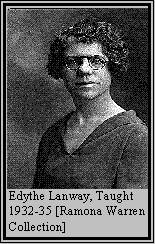
had to go to the Dayton school where state final exams were taken, according to Bill. Ramona says her tests were given in Polson. This was essentially an all-day affair. Tests were serious, pretty rigorous. When Anna Zelezny took her tests as a seventh grader in '24, she also took the eighth grade test with brother Eugene and passed it too. With nothing more to do she skipped directly to high school. [Bill Zelezny graduated with the highest scores in Lake County on these state tests despite the fact that he had skipped both second and fourth grades.]Ramona adds, "There were many honor students from the West Shore. My sister's kids went to this school too, so that was three generations who attended here. The schoolhouse had a Superior rating." The sign hanging over the school still says, "District 41 Superior School."
The Zelezny family moved to their Lonepine homestead in Sanders County, which was the closest high school, during the school year so Bill could attend Lonepine High School from 1932 to 1936 and returned to Rollins during the summer. Lone Pine High School Teachers were: John McCoy, Principal and Physics Teacher; Miss. Mildred Richards, Science & Algebra; Miss Velma Dye , English; Jack Erkkila, geometry, shop, agriculture, and basketball coach; John McCoy, Chemistry (all glassware was locked in cupboards -- used plumber's blow torches to heat glass, no running water, sink was a galvanized bucket); and Dorothy Kruger from Plains, English & History.
Ramona tells us of those who went to high school in Polson:
Anyone who went to high school previous to 1933 either stayed in Polson or Kalispell. In 1933 my
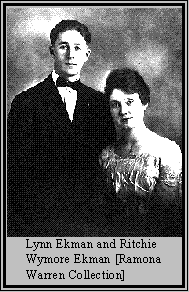
daddy bought a school bus, which he drove for 16 years so the Rollins students went to high school in Polson. We had such great times on the bus, long days as it was the longest route in the country, but we were one big happy family. The bus left home a little after seven and we got home after five. Moroea and I were lucky as we got on the bus at the garage at home. Some of the kids had a ways to walk before they got on. Mother and Daddy were dubbed Aunt Ritchie and Unk by the bus students. The busses were owned by the driver, times were tough, so when we got the school bus we had to sell the team of beautiful workhorses, big Percherons, and the only new car we ever had, a pretty blue Chevrolet sedan with shiny wire wheels. The bus was our means of transportation for several years. Can remember how the folks would take the bus to Kalispell to shows, we would have a bus load from the community. The folks loved to dance, so nearly every two weeks we'd have a load to go dancing. Babysitters were unheard of so we had the kids along with the grownups.
Each year on the last day of school the bus would have a big picnic, everyone brought food, complete with homemade ice cream.
Ramona does not mention it in her letter, but her parents and grandparents put in many years of service to the school. County Superintendent records show that Mrs. Ritchie L. Ekman served as school district clerk for four years in 1924 to 1930. Her grandfather Ed Ekman was elected trustee from 1928 through 1943. Myrtle Wymore, hergrandmother, served as district clerk from 1934 through 1943.
Other Memories of Rollins School:
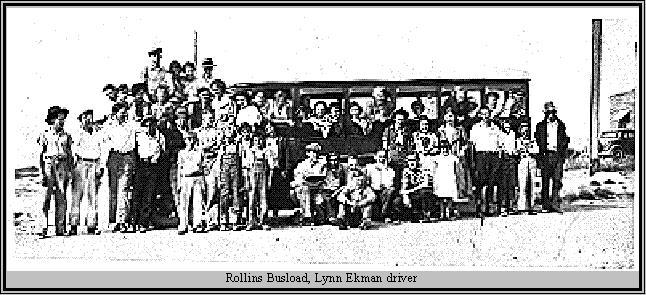
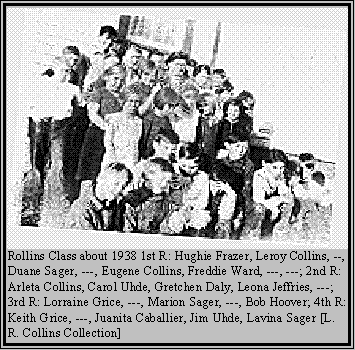
Una Sager Thomas wrote: We four Sager children went all eight grades there, as well as some of Elgie's grand-kids. Elgie worked hard with his father helping the family survive. Had his own potato field one year, some place close to where the Rollins store is now. His crop amounted to three tons of potatoes, he put them in the cellar over winter, come spring he found a market for them, had to sack them, 60-100 pound sacks. If a blizzard came up while we were at school, dad was always there to see we bundled up warm and to get us home safe or walk us to school in the bitter cold weather. County Superintendent of Schools records, beginning in 1923 when the county was formed, show Elgie Sager as a trustee in 1923 and Faye V. Sager as district clerk. Elgie Sager served again as trustee from 1925 through 1928 and again from 1930 to 1936.
Muriel (Mrs. Floren) Hamman came to Polson in the Fall of 1935. During the teacher shortage of World War II in 1943-44, she taught all eight grades at Rollins. Mrs. Hamman loved teaching and loved the Rollins area but because of the commuting back and forth from Polson to Rollins, she took
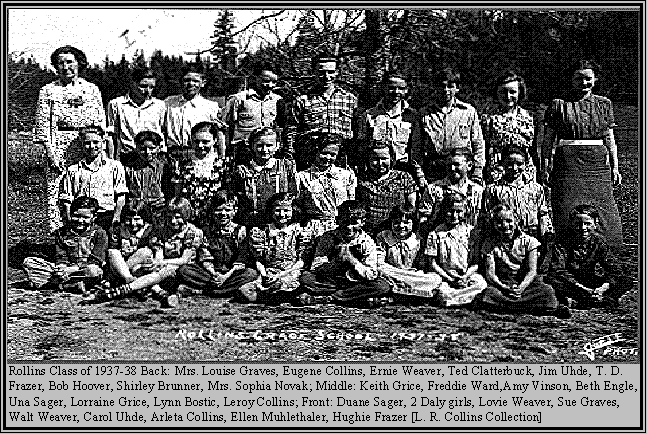
a job the next year in the Lincoln School in Polson. She taught the third grade there for ten years. She then attended school in Dillon until she got her degree in 1952.
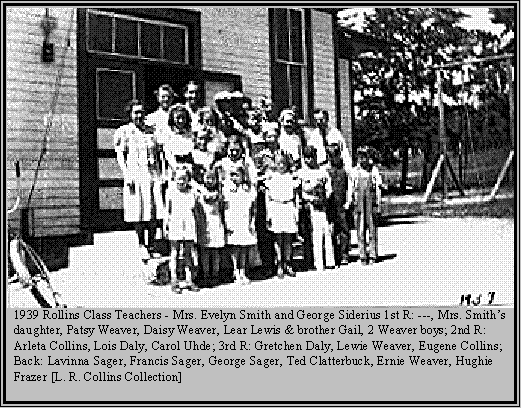
She was elected Lake County Superintendent of Schools in 1954. After two terms as county superintendent, she retired at the end of 1962. In March she made a trip to Yucca Valley, California, where they had bought a small house. She was returning to Montana when she was killed in an auto accident.
Fred Uhde served as trustee of the Rollins School District from 1943 to 1949. His wife Faith was the first president of the Rollins P.T.A.
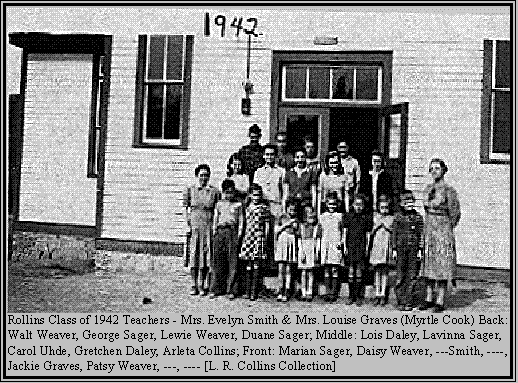
Jerry Winkley recalls his years at Rollins from the mid-40's to eighth grade graduation in 1950. He notes that during this period of time the school did not have running water. It was carried from a faucet to the south at the Brunner fence line which was an improvement from getting water at the lake. The school had two outdoor privies along the west fence below the school. What are now bathrooms were the old cloakrooms. The school was heated by a wood furnace in the basement. Stan Brunner was paid to start and tend the fire. The duct to floor register was separated slightly allowing the fire tender to target the teacher when she stood over the register, with a water pistol ! (Perhaps a story here?) This was during the 1948-50 period. He notes the teacher made numerous unscheduled trips to the girls' privy. Hot lunches were provided by mothers on a rotating basis -- probably only during the winter months. He only remembers two or three years when both classrooms were used.
Student list in 1943-1950 period(partial): as arranged and submitted to historians by Jerry H. Winkley of Rollins
Stan Brunner
Mickey Brunner
Patty Ann Smith
Gordon (Bud) Smith
Bob Smith (youngest)
Bob Garber
Alice Garber
Kay Garber
Shirley McManus
Carol McManus
Glen McManus
Lear Lewis
Gail Lewis
Jim Kimball
Ted Kimball
Gail Kimball
Daisy Weaver
Patsy Weaver
Lois Daley
Glenda Daley
Eugene Bain
Shirley Bain
Nancy Huxtable
Sally Huxtable
Marva Huxtable
Jerry Winkley
Julie McBurney
Margie L. McBurney
Jerry Daley
Roberta Daley
Vivian Weaver
Tom Weaver
Lynn Weaver
Bruce Hagen
Audrey Humphrey
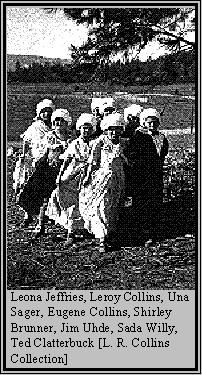
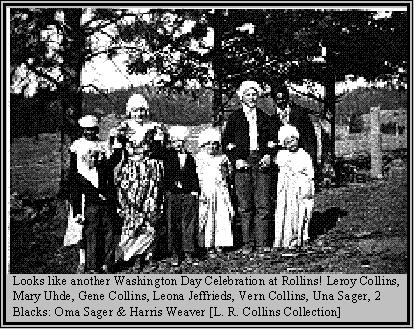
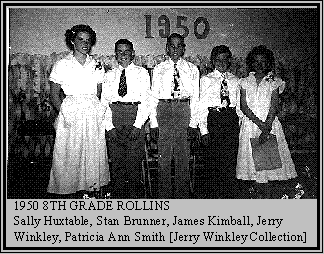
Eighth Grade Graduation ceremonies were combined between Dayton, Proctor, and Rollins School Districts and held at the Proctor School. Jerry's graduating class was: Stanley W. Brunner, Sally Huxtable, James Kimball, Patricia Ann Smith, and Jerry H. Winkley. The Lake County Superintendent of Schools J. B. Kiracofe attended to present the graduation diplomas. Jerry included a copy of his graduation program:
Invocation Rev. F.B. Hillis
Song-"Whispering Hope" Proctor
Poem - "Opportunity" by Ingalls Elmo
Poem - "Psalm of Life" by Longfellow Elmo
Songs - "Morning Serenade" -Mexican Folk Song
"The Cowboy's Life" Rollins
"The Voice of America" Dayton
"Kentucky Philosophy" Big Arm
Songs - "The Home Road"
"Ah, Lovely Meadows"
Seventh and Eighth Grades
Presentation of Diploma J.B. Kiracofe
EIGHTH GRADE GRADUATES
Big ArmProctor
Choate, Robert Coe, Joan
Ensinger, Bradley Learn, Gaybeth
Vinson, Richard
ElmoRollins
Duffield, Shirley Brunner, Stanley
Huntley, Jasper Huxtable, Sally
Stasso, Pete Kimball, James
Smith, Patricia
Winkley, Jerry
Dayton
Johnson, Dale
Nicholas, Al
Nicholas, Gene
Thomas, Nancy
Violet, Donna
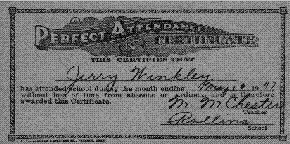
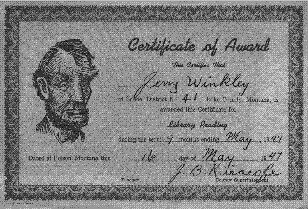
According to Jack Meuli and from the records, by 1967-68 there were not enough students for both Dayton and Rollins to operate separately so students from First to Fourth Grade went to school at Rollins and students from Fifth to Eighth attended at Dayton. Mary Rowton taught grades one and two and Rita McBride Grant taught grades three and four. Della Sampson would replace Rita for grades three and four. This pattern continued through 1971. In the 1971-72 school year, only grades one and two were held at Rollins with Mary Rowton teaching. On July 1, 1972 the school district was consolidated with Proctor and Dayton to become Upper West Shore School District #33 and now students from Rollins, if any, attend school in Dayton.
The Rollins school building is still owned by the school district and is used by the Rollins Community Club and other organizations such as the Volunteer Fire District and the Women of Rollins Club for community activities. A large barbeque is held at the school every summer to raise funds for the local firemen. In return, the Rollins Community Club has the responsibility of maintaining the building. The building is remarkably well preserved, considering its age. Bill Zelezny suggests, "this is due to being well built of excellent materials and good maintenance over the years. I personally feel that the wide overhang of the roof helped to keep moisture away from the walls and contributed to its longevity.
August 18, 1995 Joan Deily of the Women's Club of Rollins writes to Linda Gore, Trustee of the Upper West Shore (Dayton) School Board for permission to complete the paper work necessary for the Rollins School House to be placed on the National Register of Historic Places. The application has yet to be accepted.